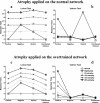The role of hippocampal atrophy in depression: a neurocomputational approach
- PMID: 19669496
- PMCID: PMC2577751
- DOI: 10.1007/s10867-008-9099-7
The role of hippocampal atrophy in depression: a neurocomputational approach
Abstract
The role of hippocampal atrophy in the pathogenesis of major depression remains under investigation. Here, we show, within a neural network model, that the incorporation of atrophy reproduces the changes observed in cognitive impairment in depression and could also contribute to the maintenance of the depressed mood. Some other clinical observations, such as treatment resistance and frequent relapses of illness, could also be explained within the framework of the model. We also simulate the action of cognitive therapy and a combined treatment of cognitive therapy and antidepressant drugs. Our findings suggest that, in the presence of hippocampal atrophy, the incorporation of antidepressant drugs would be necessary for the reversal of symptomatology.
Figures







References
-
- {'text': '', 'ref_index': 1, 'ids': [{'type': 'DOI', 'value': '10.1146/annurev.clinpsy.3.022806.091444', 'is_inner': False, 'url': 'https://doi.org/10.1146/annurev.clinpsy.3.022806.091444'}, {'type': 'PubMed', 'value': '17716051', 'is_inner': True, 'url': 'https://pubmed.ncbi.nlm.nih.gov/17716051/'}]}
- Kessler, R.C., Merikangas, K.R., Wang, P.S.: Prevalence, comorbidity, and service utilization for mood disorders in the United States at the beginning of the twenty-first century. Annu. Rev. Clin. Psychol. 3, 137–158 (2007). doi:10.1146/annurev.clinpsy.3.022806.091444 - PubMed
-
- {'text': '', 'ref_index': 1, 'ids': [{'type': 'DOI', 'value': '10.1016/S0140-6736(06)67964-6', 'is_inner': False, 'url': 'https://doi.org/10.1016/s0140-6736(06)67964-6'}, {'type': 'PubMed', 'value': '16413879', 'is_inner': True, 'url': 'https://pubmed.ncbi.nlm.nih.gov/16413879/'}]}
- Ebmeier, K.P., Donaghey, C., Steele, J.D.: Recent developments and current controversies in depression. Lancet 367, 153–167 (2006). doi:10.1016/S0140-6736(06)67964-6 - PubMed
-
- {'text': '', 'ref_index': 1, 'ids': [{'type': 'DOI', 'value': '10.1176/appi.ajp.161.11.1957', 'is_inner': False, 'url': 'https://doi.org/10.1176/appi.ajp.161.11.1957'}, {'type': 'PubMed', 'value': '15514393', 'is_inner': True, 'url': 'https://pubmed.ncbi.nlm.nih.gov/15514393/'}]}
- Videbech, P., Ravnkilde, B.: Hippocampal volume and depression: a meta-analysis of MRI studies. Am. J. Psychiatry 161, 1957–1966 (2004). doi:10.1176/appi.ajp.161.11.1957 - PubMed
-
- {'text': '', 'ref_index': 1, 'ids': [{'type': 'DOI', 'value': '10.1176/appi.ajp.161.4.598', 'is_inner': False, 'url': 'https://doi.org/10.1176/appi.ajp.161.4.598'}, {'type': 'PubMed', 'value': '15056502', 'is_inner': True, 'url': 'https://pubmed.ncbi.nlm.nih.gov/15056502/'}]}
- Campbell, S., Marriott, M., Nahmias, C., MacQueen, G.M.: Lower hippocampal volume in patients suffering from depression: a meta-analysis. Am. J. Psychiatry 161, 598–607 (2004). doi: 10.1176/appi.ajp.161.4.598 - PubMed
-
- {'text': '', 'ref_index': 1, 'ids': [{'type': 'DOI', 'value': '10.1016/S0006-3223(02)01458-0', 'is_inner': False, 'url': 'https://doi.org/10.1016/s0006-3223(02)01458-0'}, {'type': 'PubMed', 'value': '12361665', 'is_inner': True, 'url': 'https://pubmed.ncbi.nlm.nih.gov/12361665/'}]}
- Davidson, R.J., Lewis, D.A., Alloy, L.B., Amaral, D.G., Bush, G., Cohen, J.D., Drevets, W.C., Farah, M.J., Kagan, J., McClelland, J.L., Nolen-Hoeksema, S., Peterson, B.S.: Neural and behavioral substrates of mood and mood regulation. Biol. Psychiatry 52, 478–502 (2002). doi:10.1016/S0006-3223(02)01458-0 - PubMed
LinkOut - more resources
Full Text Sources

